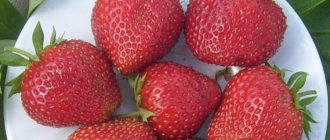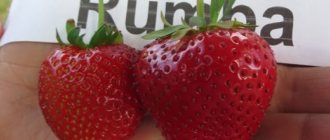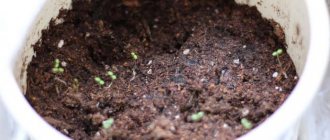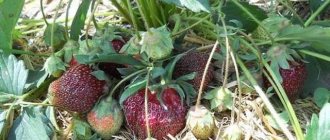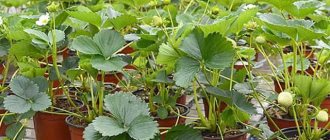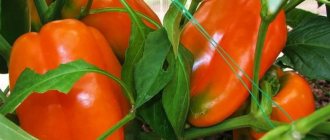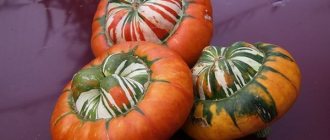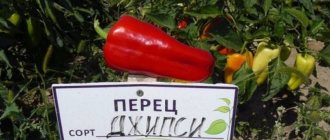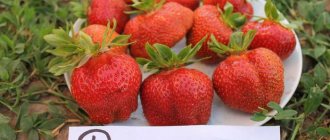Strawberry variety Elvira
Elvira is an early-ripening non-repairing variety of garden strawberries (strawberries) for universal use. It was bred in the Netherlands and has taken root well in many parts of our country. Recommended for cultivation under film covers and in greenhouses, it also shows good results in open ground. The variety is valued for its large fruit, good yield, excellent taste and resistance to various diseases, as well as shade tolerance.
The plant is powerful, medium-sized, spreading, moderately leafy. The leaves are medium sized, green in color with an emerald tint. Strawberry flower stalks are strong, multi-primed, and lie down on the ground under the weight of the harvest. The berries are quite large, wide-conical, round in shape with a neck, and very uniform in the total mass. The skin is bright red with a glossy sheen. The achenes are yellow and shallowly buried. The flesh is red, dense, but not hard, without a crunch when bitten, juicy, very aromatic.
The taste of the berries is excellent, very sweet, with a slight amount of sourness, harmoniously diluting the palette. Elvira fruits are universal in use, beautiful in their natural form, suitable for any processing, freezing, and will perfectly decorate various desserts. The berries tolerate transportation and long-term storage very well, making the variety suitable for commercial cultivation for the purpose of selling fresh produce to the market.
Strawberry fruiting is very stable, the fruits do not tend to become smaller by the end of the season, on average their weight is 30-40 grams; at the first harvest, specimens weighing about 60 grams are observed. Elvira's yield is decent; from one bush it is possible to collect from 500 grams to 1 kg of berries, or even more, depending on the intensity of agricultural technology.
The variety is very resistant to various fungal diseases, and this invulnerability extends to both the root system and green mass, as well as the fruits. Of course, prevention is still highly desirable, especially if you grow strawberries commercially and want to get maximum productivity from them. Thanks to its immunity to fungal diseases, Elvira can be grown in areas with high humidity and also does very well in greenhouses.
Our heroine has good winter hardiness and feels quite comfortable in cool regions, but shelter never hurts. The drought resistance of plants is relative; they will survive short periods without moisture, but long-term drought will have a very detrimental effect on the health and productivity of the bushes. In general, the variety is very calm about various weather fluctuations, moreover, it is shade-tolerant and can consistently bear fruit well in not very hot summers with heavy rainfall.
There are no outstanding features in the agricultural technology of this strawberry; everything is quite standard. Do not forget to carry out the most basic care measures, and also do not skimp on fertilizing if you want to get a bountiful and tasty harvest. Also, do not neglect the timely rejuvenation of the plantation. This needs to be done at least once every 4-5 years; for commercial cultivation, updating planting material is important after two years of using the plants.
Elvira is a wonderful Dutch variety worthy of a place in your garden. Unfortunately, it has not become as popular as many of its “compatriots”, and is rarely mentioned in the list of the best among early maturing varieties. However, this strawberry definitely deserves attention. Gardeners speak very warmly about her, and she has more than once been included in the group of favorites.
Reproduction
Elvira strawberries are grown in one place for no more than 4 years, then the plantation is rejuvenated.
Possible methods of reproduction:
- Seeds. The most ineffective way is labor-intensive and rarely produces the expected result.
- By division. The procedure is performed in early spring. A dug up three-year-old healthy bush is divided into several parts. A developed root system and heart are left on each. Immediately planted in the holes.
- Sockets. Elvira produces enough whiskers for reproduction. It is necessary to take care in advance of the bushes that will be used for propagation. Their flower stalks are removed and they are often fed with organic matter. The strongest first and second order rosettes are left for reproduction. For rooting directly on the garden bed, you can use plastic containers.
High-quality planting material must have at least four leaves and strong branched roots
Strawberries Elvira: description and characteristics of garden strawberry varieties
Particularly popular among strawberry varieties are those that are able to ripen in a short time, while giving high yields of large, sweet berries. This is precisely the variety that Elvira is - a large-fruited strawberry that ripens at the beginning of the summer season.
In the article, we will take a closer look at this interesting and promising variety: we will find out what its properties and qualities are, we will find out how to plant such strawberries and how to care for them. In addition, experienced gardeners will share their opinions on cultivating the Elvira variety with us.
Features of fruiting
Elvira is an early ripening variety. Its berries are among the first to ripen in our climate. Some gardeners claim that among all today's varieties, Elvira ranks first in terms of ripening speed. Its first berries, depending on the growing region, ripen in early or mid-June.
In unheated greenhouses or under film tunnels stretched over the bed with Elvira, the onset of fruiting can be accelerated by 1.5-2 weeks. The variety is not remontant, but the fruiting itself is quite extended in time (usually 6-7 weeks, but can last up to 2 months). At the same time, it remains quite intense for almost the entire period, so the harvest has to be harvested frequently.
Description
So, Elvira strawberries are a large-fruited and early-ripening variety of berries. The variety was developed in Holland and is intended for both industrial cultivation and for growing on personal plots. Strawberry Elvira has remarkable resistance to fungal infections, as well as to root lesions. It should be noted that this variety is loved by many European farmers, and it is becoming very popular in our country.
Externally, the bush is of medium size, its crown is quite spreading, and the foliage is of medium density. The fruits are large in size, round in shape, the average weight of the berry is 40-60 grams. Strawberry Elvira has a remarkably attractive appearance: the skin has a very beautiful scarlet color with a glossy sheen. It is also worth learning more about Honey strawberries; to do this, you should follow the link and read this description.
The pulp is dense, has a dark pink tint, very sweet, with a striking strawberry aroma. It should be noted that this variety is characterized by a complete absence of sourness in taste.
Strawberry Elvira is a variety that is resistant to various fungal infections characteristic of these berries. Elvira is also resistant to root rot, which is also important. For these rare properties, the variety is especially valued by gardeners, since sometimes it is not possible to provide dry beds at higher elevations for growing strawberries.
Elvira has excellent transportability and can easily be transported over long distances without losing its presentation. The yield of the variety is about half a kilogram of berries per bush. But proper care allows you to achieve higher yields of the variety: up to 1 kilogram of berries per bush.
Elvira's advantages include its cold resistance. So, the plant safely survives frosts even at -18-22 degrees without shelter. And with shelter, strawberries can winter in much harsher conditions. The variety is also tolerant of humidity, which is also important.
The purpose of this variety is universal. Elvira strawberries can be consumed fresh, as well as various tasty preparations can be made from them, used for making liqueurs, juice, and other drinks. In addition, strawberries of this variety are very well preserved when frozen due to their dense pulp.
Description of the variety
Strawberry Elvira belongs to the early varieties of SSD (short daylight hours). It is successfully grown in almost all regions of Russia, it is liked by summer residents and farmers, and shows excellent productivity when agricultural practices are followed in open and closed ground.
Bushes
A plant of medium thickness with a medium spreading crown, weakly leafy. Medium sized emerald green leaves. The root system is superficial and weak. The compact bush produces 2-3 strong peduncles, with an average of 10 flowers blooming on each. The educational ability is moderate. There are enough rosettes for propagation, but the plant does not “spread” across the area.
The best predecessors of strawberries: carrots, peas, beans, dill, parsley
Berries
The berries are round in shape, with a glossy skin. When ripe, deep red. The average weight is 30 g, the first wave often pleases with fruits weighing 50-60 g. Strawberries are tasty, very sweet. There is no sourness, despite the fact that the berry contains 35% ascorbic acid. The pulp is dense, juicy, red, without voids. During the fruiting period, a thick strawberry aroma hovers around the bushes.
Productivity
The declared yield is high - up to 1 kg. from the bush. Farmers obtain such indicators if they follow agricultural practices, proper watering and fertilizing. Under normal, and often spartan, conditions, the variety consistently produces 400-600 g.
Fruit ripening in the southern regions begins in mid-May and continues for a month. In colder areas, the dates are shifted by 2-3 weeks.
The yield and taste characteristics of Elvira are high even at high humidity and at relatively cold temperatures of +18…22℃.
How to care
Let's find out the main points regarding caring for Elvira strawberries.
Feeding
The plant is very responsive to adequate and time-appropriate feeding.
It is important to apply fertilizers during watering so that the nutrients can be completely absorbed. As for the types of fertilizers, Elvira strawberries respond equally well to both mineral compounds and organic matter. From organic matter, the crop prefers bird droppings, mullein, and herbal infusions. Of the minerals it requires nitrogen, potassium and phosphorus.
You should know that during the period of flowering and ripening of berries, you cannot feed strawberries with nitrogenous compounds, since these fertilizers are aimed at the active growth of green mass. But in early spring, nitrogenous compounds will come in handy. It is also worth learning more about the description of Festivalnaya strawberries, and what features of growing this variety currently exist.
The frequency of fertilization is as follows:
- for the first time, fertilize within two weeks after planting;
- the second time - during the period of appearance of flower stalks;
- the third time - at the beginning of fruiting.
Watering, weeding, loosening
These procedures are necessary for strawberries. It is better to carry them out simultaneously and after watering. It is important to loosen the soil not too deep: 8-10 cm maximum, as there is a danger of touching the strawberry roots. The loosening procedure allows for optimal air access to the roots and also prevents the spread of fungal infections and rot.
Weeding is also very important, since the problem of weeds when growing strawberries is always acute. Pull out the weed along with the roots to avoid its further germination.
Trimming
Since strawberries are one of those plants that form uterine shoots (whiskers) quite actively, pruning in this case is simply necessary.
If you neglect the procedure, the strawberry bed will quickly become neglected and sloppy, the plantings will turn into spontaneous ones, and the volume and quality of the harvest will decrease. Therefore, be sure to tear off all the tendrils that have formed on the plants intended for harvesting. And those bushes that are mother plants must be freed from peduncles in a timely manner so that all their forces are directed towards the formation of healthy and strong tendril shoots. But this video will help you understand what the Queen Elizabeth strawberry variety is and how it is used on the farm.
Features of cultivation
Despite Elvira’s unpretentiousness, without observing at least basic growing rules, one should not hope for high yields.
Landing
Elvira can be planted in both spring and autumn. When planting in spring, it is better to wait until the soil not only thaws, but also warms up to at least 10-12°. In the middle zone, this time occurs at the end of April - beginning of May, and further to the north - in the second half of May.
When planting in autumn, you need to calculate its timing so that before the cold weather the plants have time to take root well in the new place. For the northern regions this is approximately the last ten days of August, and for the central regions - the first half of September.
Elvira does not have any special requirements for the site, although on light fertile soils the yield will be higher. When choosing a site, you need to take into account that if the plants are constantly exposed to direct sunlight after planting, they may die. Therefore, it is better to choose a partially shaded area. If this is not possible, then in the first days after planting, Elvira bushes must be shaded.
The average height of the bush and the ability to grow and bear fruit well in partial shade allow Elvira bushes to be planted quite densely. Planting pattern recommended by experts: 30 cm between bushes in a row and 35-40 cm between rows.
When using your own seedlings to propagate the variety, choose first of all young rosettes located closer to the mother bush. They were formed first, therefore, they will be rooted and developed better than the rest.
The site for planting should be prepared in advance by carefully digging it up and selecting weed rhizomes. When digging, organic and mineral fertilizers are applied: 6-8 kg of humus (in areas poor in organic matter, the amount of humus applied should be increased to 10-12 kg), as well as 60 g of superphosphate and 25-30 g of potassium fertilizers for each m² of future strawberry bed.
Plants are planted in shallow holes dug in advance. Immediately before planting, they are watered abundantly with water to provide maximum comfort to the roots of the transplanted plants. When planting young rosettes, it is important to leave the central point of their growth above the ground, otherwise the plant will die.
Watering
While not highly drought-resistant, Elvira is demanding on soil moisture. The irrigation scheme is built depending on the growing location and weather conditions.
In elevated areas, you have to water more often, but in lowlands with a high level of groundwater, you can limit yourself to 2-3 waterings per season, and in cool, rainy spring and summer, you can do without watering at all.
In general, the recommendations of experienced gardeners boil down to the fact that Elvira should be watered as needed, without allowing the soil to dry out. But you shouldn’t be too zealous and turn your strawberry bed into a swamp - although Elvira is able to largely resist root rot, it’s still not worth provoking their appearance on the site, testing the variety for strength.
In the southern regions, where spring and summer are often hot and rainless, Elvira is recommended to be grown in beds with drip irrigation. This method of irrigation allows you to use water efficiently, obtain consistently high yields and prevent the roots from drying out and the bushes from burning out.
Feeding
Elvira is sensitive to timely feeding with both organic and mineral fertilizers. Immediately after planting, if fertilizers were applied during the preparation of the bed, fertilizing is not carried out.
If the bushes are planted in unfertilized soil, then two weeks after planting, when the plants have taken root, root feeding is carried out with an aqueous solution of mullein (1:10) or chicken manure (1:20).
In the future, they adhere to the standard feeding scheme: after fruiting, humus or well-ripened compost is placed in the inter-rows of the strawberry bed so that the plants can restore the strength spent on the formation of the crop.
In the spring, at the very beginning of the plant growing season, the plants are fertilized with ammonium nitrate or urea so that the plants quickly catch up with the ground mass. During flowering and crop formation, 2 feedings are carried out with phosphorus-potassium fertilizers. Many gardeners often add wood ash to mineral fertilizers.
Features of care
Elvira does not require any special care for herself. Regular loosening of the soil and timely removal of weeds is all that is required from its owners. It also responds well to mulching the area - this agrotechnical technique helps retain moisture in the soil, prevents the germination of weeds and protects the root system from burning out.
Without mulching, loosening the soil should be done after each watering, loosening the soil between rows by 8-10 cm, and between bushes by 4-5 cm. At the same time as loosening the plantings, they also get rid of sprouted weeds, which you should try to remove along with the roots.
On productive plantations, strawberry tendrils should be promptly removed. This will allow plants not to waste energy on growing and rooting young rosettes. For propagation, it is better to select a mother area, where, as opposed to a productive plantation, all flower stalks on the bushes must be removed.
Shelter for the winter
Despite the high frost resistance of Elvira declared by planting material distributors, many gardeners still prefer to cover its plantings for the winter.
Depending on the growing region, this shelter can be very diverse: from spruce or pine branches laid out over the bed for better snow retention to complete covering of beds in the northern regions.
In this case, the strawberry beds at the end of the growing season are freed from leaves, treated with chemical compounds against diseases and pests, and after it has completely stopped, they are covered with non-woven material, on which a layer of earth is thrown on top.
Basically, gardeners solve the problem of covering Elvira, as well as other Dutch varieties, simply: they leave a layer of covering material on the garden bed for the winter, using straw, hay, fallen leaves, etc., and remove it in early spring. If necessary, build a more reliable shelter on top of the insulating layer, you can stretch plastic film.
Reviews
Let’s find out how experienced domestic gardeners respond to growing this variety of strawberries.
- Ekaterina, Perm: “Even though I live in a cool area, strawberries of the Elvira variety have taken root quite happily at my dacha. The variety is popular because it produces high yields and because the berries ripen quickly, despite the frequent absence of sun. I recommend Elvira: this strawberry is great for growing in the northern regions. Just don’t forget to cover it for the winter.”
- Roman, Tambov: “Elvira strawberries have been growing on my farm for five years now. The variety is excellent for industrial cultivation, but I also grow it on my personal plot. This strawberry is unpretentious, survives winters safely, is resistant to diseases, and consistently produces good yields. I also really like the taste of berries: juicy and sweet.”
- Galina, Ryazan: “I grow a lot of strawberries - I grow these berries for sale. There are several varieties, but most of all Elvira. I really like this variety for its yield and excellent presentation.”
And here you can read reviews from gardeners about Gigantella strawberries.
So, we looked at the features of growing Elvira strawberries. As you can see, this large-fruited variety can be successfully used both for cultivation on a personal plot and for cultivation on an industrial scale for sale. Put our tips into practice - and you will be able to regularly harvest high yields of tasty and beautiful strawberries from your garden beds.
How to plant
Let's take a closer look at the features of planting Elvira strawberries.
Plot
In general, the variety is not particularly demanding on the site.
As mentioned above, Elvira is resistant to root rot and fungus, so it can be grown even in damp and shaded areas. However, it is necessary to place the beds on fertile soil, as this can significantly increase the crop yield. It is advisable to choose a partially shaded area for Elvira, since constant “attention” to direct sunlight in this case is destructive.
Time
It is recommended to plant strawberries in open ground either in spring or autumn. In this case, the beds for planting can be prepared throughout the summer by fertilizing them and digging them up.
Selection of seedlings
When choosing suitable bushes for seedlings, focus first on those that are located closer to the mother bush: they will produce healthy and strong adult plants that can produce a bountiful harvest.
When choosing seedlings, also pay special attention to the integrity of the foliage. It is important that the leaves are not chewed by pests and do not have diseases. Please note that defective, damaged and weak bushes are unlikely to produce a good harvest, so it is better to discard such specimens at the initial stage.
It will also be useful to learn how to plant strawberry seeds at home.
But how to grow remontant strawberries from seeds and how to care for this type of berry occurs, the information at the link will help you understand.
Origin of the form
Elvira (Elvira) belongs to the large-fruited technical varieties of strawberries of early ripening. It was bred for cultivation on industrial plantations.
Elvira is a very old variety. It was bred by Dutch breeders in the 50s of the 20th century. In Russia, this variety has been popular since the 60s of the last century. Back then, Soviet summer residents boasted that it was Elvira that grew on their plots, the seedlings of which were very difficult to obtain.
It is unknown who exactly developed this variety. This often happens with old forms of garden crops - history does not preserve the names of their creators. Therefore, Elvira is considered a strawberry of national selection.
Elvira can be successfully grown in the country. Photo: greendacha.com
Characteristics of culture
Description of the variety:
1. The bush is strong, medium-sized, semi-spreading. Its height reaches 30 cm.
2. Flowering shoots are numerous, slightly lodging. They grow at the level of the foliage or below it. Each plant produces up to 10 shoots. They bear up to 10 fruits.
3. Foliage of medium density. The plates are medium-sized, ovoid-oval, emerald green.
4. The color is bisexual, multi-petaled, large. Its lobes are white, and the middle with pistils and stamens is yellow.
5. The fibrous root system has high growth vigor. It is well developed and branched
1. Elvira fruits are round-cone-shaped, large, dense, elastic.
2. Fully ripened berries have a glossy and bright red skin. It is dotted with small, deeply pressed yellow seeds. Slightly overripe burgundy strawberries.
3. Average fruit weight 30–60 g
Elvira is an early ripening variety of strawberry.
Its first wave of berries ripen already in the second ten days of June
- on average, 0.5–0.7 kg of strawberries are harvested from one Elvira bush;
- with careful care and proper agricultural technology, you can remove up to 1.2 kg of berries from a plant
1. Elvira’s pulp is red, dense, juicy, without the characteristic void in the middle of the fruit.
2. The taste of the dense pulp is richly sweet, without a sour aftertaste.
3. The fruits are very fragrant, they smell like wild strawberries.
Elvira's taste rating is 4.5 out of 5
This variety is universal:
- it can be used as a dessert and eaten fresh;
- when processing berries, they are used to produce juices, mousses, preserves, marmalade, marmalade, and candied fruits;
- they make fragrant homemade wine, liqueurs, and liqueurs from the fruits
1. Garden strawberry Elvira is frost-resistant. Without additional insulation, it can withstand cold temperatures down to -23 ºC.
2. The culture is moisture resistant. It tolerates rainy weather well.
3. Drought resistance of strawberries is poor. Therefore, it needs regular watering.
4. Elvira has a high level of resistance to fungal and bacterial diseases of fruits, foliage and roots. It is rated 3–3.5 points out of 5.
Based on its characteristics, Elvira strawberries are recommended to be grown in central Russia. In the south of the Russian Federation, Elvira develops well in beds with built-in drip irrigation. In greenhouse conditions, the crop can be grown in Siberia and the North of the country
Elvira berries
The berries of this variety usually grow in an almost regular conical shape and are quite large - from 50-60 g in the first pickings to a modest 20-30 g at the end of fruiting.
Ripe berries attract attention with their rich red color and clearly visible glossy shine. Their flesh is red, very dense and juicy. There are no voids inside the pulp characteristic of many large-fruited strawberry varieties.
Ripe Elvira berries contain:
- sugars - 6%;
- dry matter - 12.5%;
- ascorbic acid - 35%.
Elvira's taste is sweet, with a subtle sourness. Also, its berries are characterized by a strawberry aroma, very thick and fragrant. Experts rated the taste qualities of Elvira berries at 4.5 points on a 5-point scale.
The berries are intended for fresh consumption; they can be used to prepare delicious preserves, jams, compotes and candied fruits. They are also suitable for the production of alcoholic beverages: liqueurs, liqueurs, etc.
Also, Elvira berries, due to their dense pulp, tolerate freezing well. After defrosting, they retain their taste and all the beneficial substances they contain.
Opinions of users who started growing Elvira
Reviews from gardeners:
Roman, Tambov:
“Elvira strawberries have been growing on my farm for the fifth year. The variety is excellent for industrial cultivation, but I also grow it on my personal plot. This strawberry is unpretentious, survives winters safely, is resistant to diseases, and consistently produces good yields. I also really like the taste of berries: juicy and sweet.”
Daria, 50 years old, Mari El:
“A Dutch variety, early and productive, popular among farmers. It has been growing on our site for more than 5 years. The bushes are compact, the activity of plant formation is average. Among the disadvantages, I note a weak superficial root system, which can freeze in winter without shelter, as well as the need for regular watering and shading in the heat. Fruits well in partial shade and damp areas. After harvesting, it is imperative to carry out fertilizing and preventive treatments, since intensive fruiting greatly depletes the plants, and they become more vulnerable to diseases and pests.”
Growing and care
Elvira is an unpretentious variety, but the gardener should make an effort to get a good harvest.
Watering
It is preferable to organize drip irrigation. Automation will protect strawberries from stress when the heat sets in and provide them with regular watering in the right dosage.
Strawberries especially need irrigation during flowering and fruit set. In dry, hot weather, strawberries are watered every 3-4 days.
Soil drying out in beds with Elvira strawberries leads to a sharp decrease in yield
Loosening, weed control
Regular loosening helps fight weeds, improves air flow to the roots, and maintains soil moisture. The Elvira variety has a shallow root system, so loosening around the bushes is carried out to a depth of no more than 1-2 cm. The amount of watering and loosening can be reduced by mulching. The optimal mulching material is a mixture of peat and humus with a layer of 2-3 cm.
Sand is added to heavy soils to loosen them; more organic fertilizers are added to sandstones.
Removing a mustache
Bushes left for fruiting rather than propagation will get rid of the mustache. It is necessary to monitor the mustache throughout the summer season, even after the fruiting period has ended. The best option is to divide the plantation into mother and fruiting bushes. Remove the peduncles from the queen bees and leave the whiskers.
Top dressing
Timely fertilizing has a good effect on the productivity of the variety.
Adhere to the following scheme:
- In early spring, you need to feed strawberries with nitrogen fertilizers. For example, apply complex fertilizer “Spring” 25-30 g for 2-3 bushes. You can also prepare the following composition: 1 kg. pour 8 liters of rotted manure. water, add 60 g of superphosphate and 250 g of ash. Water the plants at the root at the rate of 1 liter. fertilizers for the bush.
- During the period of flower stalk growth and setting, the plant needs potassium and phosphorus supplements.
- After collecting the last wave of ripe berries, it is recommended to add phosphorus-containing preparations.
How to care for strawberries
- Elvira gives a bountiful and tasty harvest only on light, fertile soil. The optimal soil for strawberries is loam, forest gray soil or chernozem.
- The crop plantation should be semi-shaded. The bright summer sun can burn developing plants.
Without a developed root system, the seedling will not take root in the soil.
Photo: static.dom.by When choosing planting material, pay attention to its quality. Healthy seedlings should have at least 4 developed leaves of emerald green color. The root of the plant should be well developed.
When planting strawberries, the spacing between seedlings should be 30 cm, and the row spacing should be 40 cm. Photo: fermer.blog
- When rooting sprouts in a greenhouse, a planting pattern of 0.25 × 0.3 m is used. In open ground, strawberries are planted according to a pattern of 0.3 × 0.4 m.
- Before planting the bushes, the soil is moistened and dug up. Then holes are dug in it.
- The sprouts descend into the holes up to the main growth bud. This point should be level with the ground.
Caring for Elvira is not difficult, but it must be constant and timely. First of all, this concerns feeding and watering plants, weeding and loosening the soil.
It is best to fertilize strawberries with a ready-made preparation. Photo: atmagro.ru
There is no need to feed strawberries too often. It is enough to fertilize it 3-4 times per season:
- during the first 14 days after rooting in open ground;
- at the beginning of flowering and after its end;
- during the period of fruit set and development.
Mineral fertilizers must contain nitrogen, phosphorus and potassium. It is advisable to mix them with organic fertilizer: humus, chicken droppings, infusion of herbs.
When color appears on the plants, nitrogen-containing preparations are removed from the fertilizers. They contribute to excessive growth of green mass and reduce strawberry yields.
Strawberries should be watered once every 7–10 days. Photo: agronomu.com
The crop should be watered constantly, but moderately. This is done once a week, early in the morning or in the evening, after sunset. For each bush, 3 liters of water is enough.
The beds need to be loosened periodically, it is best to do this after watering. In this case, the soil will be saturated with oxygen, therefore, the development of strawberries will accelerate.
To increase the yield of a crop, you need to regularly pinch out the growth tendrils on its bushes. In this case, the plant feeding area will expand.
Landing
The variety can be planted in spring, summer and autumn. In the Moscow region and the Urals, they choose an open sunny space, in the Krasnodar Territory - an area with openwork shade. Areas with high humidity are suitable; they will not cause harm to Elvira strawberries.
The soil is prepared in advance. If you want to get a significant harvest, you will need to add 10 kg per square meter. manure and a glass of wood ash. Wood ash can be replaced with superphosphate (100 g) and potassium sulfate (120 g).
Optimal acidity level for strawberries: 5.2-5.5 pH. If the soil is more acidic, then one to two years before planting, deacidification is carried out using 400-600 g of lime or dolomite flour per m2. Dolomite flour is more preferable because enriches the soil with magnesium.
The most convenient two-line planting scheme is:
- in a greenhouse, plants are planted according to a 25x25 cm pattern;
- in open areas 30x30 cm;
- between the two-line tape leave a gap of 50-70 cm;
- To ensure uniform illumination, the rows are arranged from north to south.
Form ordinary beds or spread black spunbond. The second option will save you from tedious weeding. The holes are thoroughly watered before planting.
Seedlings cannot be buried; the heart must remain above the soil surface
Advantages and disadvantages of the variety
Why do they love Elvira strawberries and what are the advantages of this variety:
- First of all, this is productivity. Under the most favorable conditions, more than a kilogram of berries can be collected from one bush per season. Typically, the average harvest is from 600 to 900 grams.
- An important characteristic for growing in Russia is frost resistance. Garden strawberries of this variety can overwinter down to a temperature of -20, and with additional shelter they can withstand even more severe frosts.
- Resistance to fungal diseases. Any summer resident who has garden strawberries on his property has encountered gray rot on the fruits or brown spots on the leaves. These are manifestations of fungal diseases that infect plants and destroy crops. Strawberry Elvira is resistant to fungal diseases, and this applies to all parts of the plant - berries, leaves, roots.
- Early maturation. The berries turn red already at the end of May - beginning of June when grown in open ground, and if the bushes are planted in greenhouses, the harvest can be obtained even earlier.
- Length of the harvest season. The fruits do not all ripen at the same time, but one at a time, which allows you to enjoy freshly picked berries for as long as possible.
- Versatility. The variety is suitable for both amateur gardeners for cultivation on their own plots, and farmers for production for sale on an industrial scale. Plants are grown both in open ground and in greenhouses.
- Storage and transportation. Thanks to the non-loose pulp without voids and dense skin, the berry is well stored and can withstand transportation, which makes it suitable for growing for commercial purposes.
- Usage. The fruits of this variety can be eaten fresh, frozen, used as a filling for pies and a base for desserts. The berries are suitable for making preserves, marmalade, marmalade, compotes, fruit drinks and even liqueurs.
- Shade tolerance. Bushes can and should be planted in shaded areas. Direct sunlight is even harmful to the plant.
Productivity
From one Elvira bush you can collect an average of 500-600 g of berries per season. But this is far from the limit: in favorable years, with proper care, the yield can reach up to 1 kg of berries per bush. Some gardeners in their reviews indicate a truly fantastic figure - up to 2 kg of berries per bush.
Thanks to their dense pulp, Elvira berries can be stored for a relatively long time without losing their shape or taste. They are also suitable for transportation over long distances. Experts rated the safety and ability to transport berries highly - 4.5 points on a 5-point scale.
The subtleties of growing strawberries Elvira
To get the maximum yield from each bush, you must adhere to the rules that are most suitable for a given variety. There are several points to pay attention to.
When is the best time to plant new bushes?
Plants can be planted both in autumn and spring. It is convenient to plant in the fall, since the beds can be prepared throughout the summer season. Young bushes planted in autumn under favorable conditions will produce the same harvest as adult plants next summer. Young bushes planted in the spring will give a good harvest only the next year.
Preparation of planting material
The most competent way is propagation by rosettes, more about it. To avoid degeneration of the variety, it is important to choose the right rosettes for further propagation. First, a mother plant is determined to obtain planting material. It should be a strong bush, the leaves, stems and tendrils of which are not affected by diseases and pests. To make the bean formation more intense, the peduncles are removed. Several rosettes can take root on each tendril, but for propagation, those located closest to the mother plant are taken.
Before planting, seedlings are carefully checked. Weak plants, as well as seedlings with damaged leaves and roots, are discarded. It is easier to eliminate non-viable material at this stage.
If these nuances are observed, the characteristics of the variety will be preserved and a good harvest will be obtained.
How and where to plant?
What factors should you pay attention to when choosing a landing site:
- The area should be slightly shaded - direct sunlight can burn the plants. Beds that are illuminated in the morning and remain in the shade during the hottest times are well suited. If there is no natural shade, the bushes must be protected from the sun during the daytime.
- The variety is unpretentious in terms of site humidity. Since the root system of the plant is slightly susceptible to rot, moist soils and lowlands are suitable for setting up beds.
- Soil fertility does not play a big role for these unpretentious plants. Despite this, to obtain a good harvest, you will need to pay special attention to proper and timely fertilizing if the soil is poor.
How to plant prepared seedlings correctly?
The seedlings are placed in a prepared, well-moistened hole. The root system must be carefully straightened. The more water in the hole, the better the roots will be distributed. Having covered the roots with soil, the soil is gently patted down for better adhesion and elimination of excess air. The growth point cannot be covered.
The holes are placed at a distance of 25-30 cm from each other, the distance between the rows is at least 30 cm. There are staggered planting patterns, but this arrangement is less convenient for drip irrigation.
After planting in open ground, the soil can be mulched with sawdust or other suitable material.
Characteristic
When you want to plant something new on your plot, in addition to descriptions, reviews and photos of the Elvira strawberry variety, you want to know the pros and cons of the plant.
Advantages
- Early ripeness. The first berries of the variety ripen in mid-June, when other strawberry plants are just beginning to ripen.
- Unpretentiousness. Strawberries can be grown in any soil. Tolerates rainy and dry weather.
- Long-term fruiting. The berries do not ripen on the bushes at the same time, so you can enjoy the aromatic garden strawberries of the Elvira variety until autumn.
- Storage. Dense berries are stored for a long time, do not soften or leak, do not rot, and do not lose their beneficial properties.
- Transportability. The elastic berries of the variety do not lose their marketable appearance even when transported over long distances, which is especially attractive to farmers who grow strawberries for sale.
- Cold resistance. Elvira strawberries can be safely grown in harsh conditions, as they overwinter without loss at a temperature of -20 degrees.
- Immunity. Plants practically do not suffer from fungal diseases and are little damaged by pests.
Comment! All parts of the strawberry remain healthy: root system, leaves, fruits.
Flaws
Gardeners do not note any obvious disadvantages of the variety. Disadvantages are often called the need to:
- loosen the soil frequently;
- picking berries in several stages (although for some this is a plus!);
- cover Elvira strawberry plantings for the winter if the winter temperature is below 22 degrees.
Features of reproduction
As a rule, the Elvira variety is grown in one place for no more than 4 years. Then the plantings will have to be rejuvenated. Dutch strawberries reproduce in different ways:
- seeds;
- sockets;
- dividing the bush.
Seed method
Growing seedlings from seeds is a labor-intensive and not always rewarding task. Even experienced gardeners do not always succeed, since the seeds often do not germinate. The shelf life of strawberry seed is limited.
Important! But failures lie not only in the quality of seeds; the reason for the lack of sprouts of Elvira strawberries can be a violation of the technology for growing seedlings. If you want to experiment, then seeding material (including seedlings) should be purchased from trusted suppliers, nurseries or, for example, from the companies Gardens of Russia, Siberian Garden, Becker and others
If you want to experiment, then seeding material (including seedlings) should be purchased from trusted suppliers, nurseries or, for example, from the companies Gardens of Russia, Siberian Garden, Becker and others.
Advice! You can also collect your own seeds from ripe Elvira berries.
Dividing the bush
In the spring, when the buds are just waking up, choose a healthy strawberry bush, dig it up and divide it into parts. Each of them should have a well-developed heart and root system. The divisions are planted in prepared holes.
Rosettes
This is the most convenient way to propagate strawberries, including the Elvira variety, since the growth of strawberries is sufficient. But there are some nuances here; mistakes when choosing rosettes for planting strawberries can lead to degeneration of the variety.
Experienced gardeners deliberately leave mother bushes for further propagation. To obtain high-quality rosettes, the flower stalks are removed. When choosing planting material, assess the condition of the mother bush and rosettes. Plants should not have leaves damaged by diseases and pests.
There may be several rooted rosettes on the tendrils, but for planting you need those that are located in close proximity to the mother bush. In this case, one can hope to preserve the properties corresponding to the description of the variety.
Strawberry rosettes are best rooted in separate containers. Before planting, the plants will have time to develop a good root system and new leaves will appear. Planting material that takes root well should have at least four leaves, as in the photo below.
Attention! In case of any defects in the leaves and root system, strawberry rosettes of any variety are discarded. Garden strawberries, first fruiting:
Garden strawberries, first fruiting:
How to care
To achieve maximum productivity, we must not forget about the rules of plant care.
Feeding
Throughout the season, fertilizing is applied repeatedly. It is recommended to adhere to the following order in terms of application timing and types of fertilizers:
- Before landing. Mineral and organic fertilizers are used when preparing beds for planting rosettes. Humus or compost, as well as wood ash, are added under the holes.
- Two weeks after landing. In order to help the bush grow green mass, use nitrogen fertilizers or ammonia.
- During flowering and fruit formation, the plant needs phosphorus and potassium. At this stage, nitrogenous compounds are avoided so as not to provoke the growth of green mass.
- When preparing strawberries for wintering, the plants are again fed with phosphorus-containing fertilizers.
Watering, weeding, loosening
Despite the unpretentiousness of the Elvira variety, the main maintenance requirement is almost daily watering and loosening. Water the plant at the root. After irrigation, the soil is loosened to a depth of no more than 10 cm so as not to damage the roots. Loosening helps saturate the soil with oxygen, prevents moisture evaporation, and helps eliminate small weeds.
Weeding of beds is required as needed. It is important to remove weeds in a timely manner so that they do not interfere with the growth of cultivated plants and do not contribute to the spread of diseases and pests.
Trimming
Fruit-bearing plants need to remove all tendrils to improve fruit formation and, accordingly, obtain maximum yield. If you leave the mustache, the plant will grow, and the bed will take on a sloppy and neglected appearance. Bushes selected for propagation, on the contrary, have their flower stalks removed. At the same time, the plant forms strong tendrils capable of producing rosettes that are promising for preserving the best characteristics of the variety.
Mulching
Mulching is required to retain moisture in the soil, prevent the growth of weeds, and in winter it saves plantings from freezing. Also in some cases it is used to improve the survival rate of plantings and to combat diseases. Sawdust, humus, and straw are most often used as mulch.
Shelter for the winter
Strawberry Elvira winters well down to -18 degrees without additional shelter. If there is little snow in the region and the frost is severe, it is necessary to cover the bushes either with natural material (usually spruce branches, straw, tops are used) or with special agricultural coverings with the production of an auxiliary frame.
Diseases
According to foreign and Russian experts, the variety is resistant to brown leaf spot and strawberry mite damage, sensitive to powdery mildew, moderately susceptible to late blight (red) root rot, relatively resistant to gray fruit rot and verticillium wilt, and neutral to anthracnose.
Pests
The variety is considered to be less susceptible to pests typical of garden strawberries. However, the berries can be damaged or completely destroyed by birds or wasps. Methods of dealing with them are standard.
Brief characteristics, description of Elvira
Photo:
The variety was originally bred for industrial cultivation, but in our country it is widely cultivated in private gardens. It can be grown both in greenhouses and in open ground.
According to some reviews, with due diligence, Elvira is able to grow and bear fruit as a hanging plant - in a room on the windowsill, the main thing is to provide the bush with a suitable size flower pot.
Elvira's bushes are medium-sized and quite spreading. The foliage of the bushes is average. The leaves are medium sized, bright green. Peduncles grow level with the leaves or slightly below them; usually each bush throws up to 10 of them. Each of them produces up to 10 large berries. The flowers are bisexual, large, white, with well-developed pollen-rich stamens.
The adaptation is average. Despite this, young rosettes are sufficient for rapid propagation of the variety. Due to the rather large dimensions of Elvira’s bushes, it is better to remove her mustache, if there is no question of reproduction.
According to the distributors of Elvira seedlings, the variety is highly resistant to the main problems of strawberries: fungal infections, leaf diseases and root rot. Elvira also tolerates high humidity well.
These properties make it possible to plant it even in low-lying areas with a high level of groundwater. Also, this variety is almost ideal for growing in heated and unheated greenhouses.
In fact, according to domestic scientists, the variety stoically tolerates brown leaf spot and is practically not affected by the strawberry mite. Elvira is also relatively resistant to verticillium and gray root rot. But the variety is quite sensitive to powdery mildew and moderately susceptible to red root rot, so you shouldn’t count on absolutely problem-free cultivation.
Elvira is a fairly frost-resistant variety: without additional protection, it can withstand frosts down to 20° below zero, although it is guaranteed to tolerate temperatures down to minus 15° without any harm.
With proper winter shelter, it can safely withstand cold temperatures of minus 30°. It also copes with short-term spring frosts on the ground surface without any problems.
Elvira prefers to grow in well-lit areas, but almost does not reduce its productivity in partial shade. The undoubted advantages of the variety include the fact that it is able to form and fill berries even in relatively low temperatures - 18 - 23 °.
The “Achilles heel” of the variety is its poor drought resistance. When exposed to severe drought, plants simply burn out without sufficient watering. The reason for this is the root system, most of the roots of which are located in the top layer of soil.
Harvesting and storage rules
The berries ripen in stages, starting in late spring - early summer. They are collected as they ripen. The collected fruits are stored for a long time, subject to the rules standard for garden strawberries.
When a new variety is developed, they try to improve its characteristics, adapt it to climatic conditions, and make it more attractive to those who will grow it and those who will consume the final product. Despite the fact that the Elvira strawberry variety was bred in the Netherlands, the Russians also liked it. No wonder gardeners affectionately call the variety Elechka.
Sources:
https://sortoved.ru/klubnika-zemlyanika/sort-klubniki-elvira.html https://gidfermer.com/sadovodstvo/yagody/klubnika-elvira-opisanie-sorta.html https://qlumba.com/sad/ 1107-klubnika-elvira https://dachamechty.ru/klubnika/elvira.html
